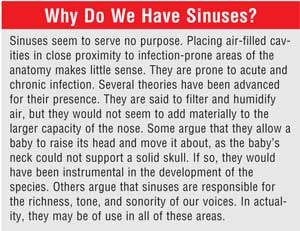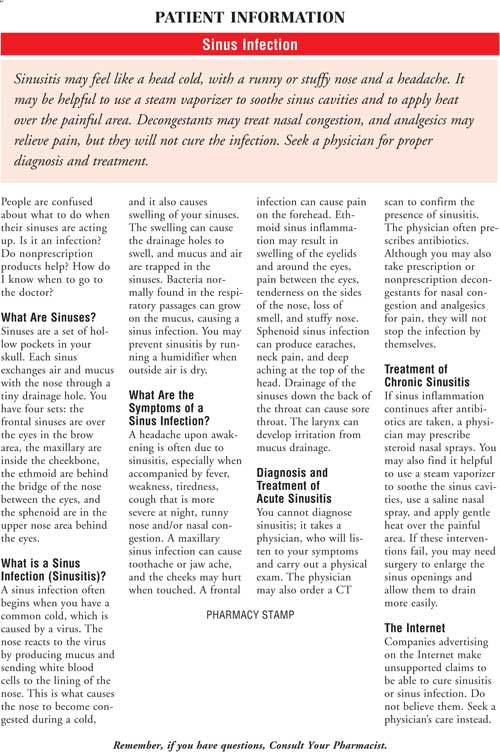US Pharm. 2007;32(7):12-15.
Although many nonprescription
products are marketed for sinus congestion and sinus headache, the FDA aims to
ensure that products labeled for sinusitis will never again be sold on a
nonprescription basis.
Sinusitis
The paranasal
sinuses are several symmetrical sets of sterile, air-filled cavities in the
skull.1,2 Sinusitis is defined as inflammation in one or
more of these paranasal sinuses.2,3 The sinuses are lined with
cells that resemble the lining of pulmonary passages.1 Ciliated
cells move in a coordinated manner to transfer materials to the small sinus
drainage holes (ostia). Goblet cells produce mucus that serves to trap
pollutants and infective invaders for removal. Paranasal sinus inflammation
can result in inflammation of the ostia, which allows mucus to become
entrapped in the sinuses, usually leading to bacterial infection.
Sinusitis (rhinosinusitis) is
an increasingly common condition, affecting as many as 31 to 37 million
Americans every year.4,5 Chronic sinusitis affects 32 million
patients annually.5 It is responsible for 20% of office visits to
allergists and immunologists.1
Acute Versus Chronic
Sinusitis
Sinusitis has many
potential etiologies, being induced by viral, bacterial, fungal, or allergic
mechanisms; a substantial number of cases are thought to be idiopathic in
nature.4 The major categories of sinusitis are acute, subacute, and
chronic. Sinusitis lasting less than four weeks is acute, while cases
persisting for four to 12 weeks are subacute; the condition is chronic if it
extends for more than 12 weeks.1 Acute sinusitis is virtually
always bacterial in origin. Infective bacteria include those that also cause
acute otitis media, (e.g., Streptococcus pneumoniae, Haemophilus
influenzae, and Moraxella catarrhalis).4,6-9 However,
chronic sinusitis can be caused by many other
etiologies.
Symptoms of Sinusitis
Symptoms of acute
sinusitis include fever, headache, facial pain, cough, postnasal drainage,
halitosis, fatigue, hampered smell, nasal congestion, and rhinorrhea that may
involve pus or blood.1 Patients may feel pain in the teeth or ears,
due to the phenomenon of referred pain. When sinusitis becomes chronic,
the hallmark symptoms are purulent rhinorrhea, nasal congestion,
anosmia/hyposmia, and postnasal drainage.1
Sinusitis and the Common
Cold
Pharmacists field
many questions about sinusitis related to the common cold. Patients typically
recite symptoms of a recent common cold that have largely abated but complain
of persistent sinus pain. During the cold, nasal fluids are forced into the
sinuses.4 They carry viruses, bacteria, and inflammatory mediators,
causing inflammation and/or infection. Goblet cells in sinuses produce mucin,
which thickens mucus. Mucosal edema partially or totally occludes the ostia,
leading to pressure within the sinuses, causing pain in the specific sinus(es)
infected.
The Market Prior to 2004
Many products are
now or have been marketed for problems related to sinus congestion. Many carry
(or carried) the names of well-known product lines through the marketing
tactic known as "line extensions." These products included Advil Cold & Sinus,
Contac Sinus, Dristan Sinus, Motrin IB Sinus, Sudafed Sinus, Tavist Sinus, and
Tylenol Allergy Sinus. There were also sinus-specific trade names (e.g.,
Sinutab and Sine-Off). A new FDA ruling will restrict how these products are
labeled.

FDA's 2004 Proposed Rule on
Sinusitis
On August 2, 2004,
the Federal Register carried a proposed rule entitled, "Proposed Amendment of
Final Monograph for Over-the-Counter Nasal Decongestant Drug Products."
10 This document presented serious issues for companies selling sinus
products.
The FDA explained that the
indication "For temporary relief of nasal congestion associated with
sinusitis" had been one of the 13 original indications recommended by the
Advisory Panel on OTC Cough, Cold, Allergy, Bronchodilator, and Antiasthmatic
Drug Products in its 1976 report. The FDA explained that the panel did not
provide any explanation for that indication, implying that there was no
appropriate justification for the indication from its inception.
The FDA discussed the
pathology of sinusitis, explaining that it is characterized by inflammation of
the paranasal passages. The FDA stated that normal primary care
provider/subspecialist care for acute and chronic sinusitis would include an
antibiotic prescription, due to the high propensity for the condition to have
a bacterial etiology.
The FDA also pointed out that
many nasal diseases mimic sinusitis, such as allergic rhinitis, nonallergic
rhinitis, the common cold, influenza, Wegener's granulomatosis, acquired and
congenital immunodeficiency diseases, nasal polyposis, sarcoidosis, fungal
sinusitis, and neoplasia.
The FDA observed that
sinusitis and asthma often coexist in the same patient. Perhaps 40% to 70% of
those with asthma also have sinusitis. Finally, the FDA explain ed that
acute bacterial sinusitis may lead to rare complications culminating in
blindness or death, such as infections of the orbit of the eye and/or
infections of the central nervous system.
The FDA found no prospective
studies proving the efficacy of decongestants in sinusitis. Even data
demonstrating their efficacy as adjuncts were limited and clouded by
controversy. The agency admitted that prescribers recommend them as adjunctive
therapy but only within the context of a physician–patient relationship. This
practice would not justify self-diagnosis or self-management of sinusitis. The
FDA also discovered preclinical evidence that use of decongestants can
increase the degree of sinus inflammation, having a negative effect on the
resolution of sinusitis.
The FDA became concerned that
current labeling may mislead consumers to believe that decongestants alone are
suitable for sinusitis, rather than a physician appointment for diagnosis and
treatment. A delay in seeking medical care might also delay recognition of a
serious illness mimicking sinusitis. Furthermore, a bacterial infection would
worsen without prompt treatment. Patients who also have asthma might have
complications due to both conditions if allowed to use nonprescription
products as the sole therapy.
As a result of FDA's concerns,
the agency proposed in the 2004 document to remove the phrase "associated with
sinusitis" from the list of FDA-approved indications. Companies would still be
allowed to claim "helps decongest sinus openings and passages, temporarily
relieves sinus congestion and pressure, and/or promotes nasal and/or sinus
drainage."
FDA's 2005 Final Rule
FDA received
positive and negative comments in response to the 2004 report and considered
each comment, but in its 2005 "Amendment of Final Monograph for
Over-the-Counter Nasal Decongestant Drug Products," the agency prohibited the
wording, "for the temporary relief of nasal congestion associated with
sinusitis," "sinusitis," and "associated with sinusitis" on all
nonprescription products.11 The prohibition took effect April 11,
2007 for products with annual sales of $25,000 or more yearly. The compliance
date for products with less than $25,000 annual sales is October 11, 2007.
The Impact of FDA's Ruling
The FDA action
could have far-reaching consequences. If one enters sinusitis as a
search term in Google, it returns 4.3 million hits. However, the search
results page also includes many sponsored links. An examination of Google's
sponsors reveals claims that should require FDA action.
One is for Sinus Doctor, a
product containing three plant extracts claiming to give relief from sinus
misery in only three minutes.12 Evidently discovered by a
nonphysician "sinus researcher," it claims superiority to antibiotics, nasal
sprays, decongestants, irrigation, and sinus surgery. Regarding those proven
therapies, the site states, "You and I know they simply don't work."
12 The FDA-unproven herbal concoction costs $67.
A second Google sponsor is
stopyeast.com. The site cleverly provides a link to a Mayo Clinic report
stating that chronic rhinosinusitis may be caused by an immune reaction to
nasal fungi.13 The site uses that report to discuss candidal
overgrowth as a cause of sinusitis and sells FDA-unproven products known as
"ThreeLac" (a "probiotic") and "Oxygen Elements Plus" (a "pat
ent ed liquid oxygenator").14,15
A third Google sponsor is
colloidal-silver-colloids.com. The site includes the statement: "FDA and FTC
Censorship robs the American people of health information indispensable to
their exercise of freedom of choice…. The solution lies in a new law, one that
will strip FDA and FTC of their censorship powers."16 The
site sells Mesosilver, containing colloidal silver with claims to "clear the
congestion and post nasal drip of sinus infection (sinusitis)."16
Citing lack of safety and efficacy data, FDA prohibited sales of colloidal
silver in 1999.17,18 Its persistence online is puzzling. Perhaps
the new ruling can help remove unknown products with unproven claims such as
this one.
Another Google sponsor is
AsthmaQuell, "The Natural Path to Respiratory Health."19-22
The unproven product contains echinacea and turmeric, allegedly effective for
chronic allergy, asthma, lung ailments, sinus infections, severe histamine
reactions, and in the reduction or elimination of colds or flu.
A final Google sponsor of
interest is www.miraclesinusitiscure.com. This Web site claims to reveal how
to get rid of a painful sinus infection within 24 hours using an ancient
remedy.23 The site provides claims, testimonials, FAQs, and gives
clear advice for ordering their Sinus Infection Miracle Cure. The site even
offers a spurious observation that taking antibiotics damages the immune
system. However, the site fails to reveal the name of the ingredients, a
tip-off to the fact that they are not proven safe and effective in meeting any
of their extravagant claims.
References
1. Klemens JC,
Ditto AM. Sinusitis. Allergy Asthma Proc. 2004;25(Suppl 1):S18-S20.
2. Taylor A. Sinusitis.
Pediatr Rev. 2006;27:395-397.
3. Wright WL. Viral or
acute bacterial rhinosinusitis? Determining the difference. Nurse Pract
. 2005;30:30-41.
4. Meltzer EO, Hamilos
DL, Hadley JA, et al. Rhinosinusitis: Establishing definitions for clinical
research and patient care. J Allergy Clin Immunol. 2004;114(6
Suppl):155-212.
5. Sinusitis. National
Institute of Allergy and Infectious Diseases. Available at:
www.niaid.nih.gov/factsheets/sinusitis.htm. Accessed May 7, 2007.
6. Durbin WJ.
Pneumococcal infections. Pediatr Rev. 2004;25(12):418-424.
7. Pichichero ME,
Brixner DI. A review of recommended antibiotic therapies with impact on
outcomes in acute otitis media and acute bacterial sinusitis. Am J Manag
Care. 2006;12(10) Suppl:S292-S302.
8. Piccirillo JF.
Clinical practice. Acute bacterial sinusitis. N Engl J Med.
2004;351(9):902-910.
9. Anon JB, Jacobs MR,
Poole MD, et al. Antimicrobial treatment guidelines for acute bacterial
rhinosinusitis. Otolaryngol Head Neck Surg. 2004;139(1) Suppl:1-24.
10. Proposed amendment
of final monograph for over-the-counter nasal decongestant drug products.
Fed Reg. 2004;69:46119-46122.
11. Amendment of final
monograph for over-the-counter nasal decongestant drug products. Fed Reg
. 2005;70:58974-58977.
12. Sinus infection?
Fullpoint Health Products. Available at: www.sinusinfectiondiscovery.com.
Accessed May 7, 2007.
13. Research on chronic
sinusitis. Mayo Clinic. Available at: www.mayoclinic.org/
ent-rst/chronicsinus.html. Accessed May 7, 2007.
14. How to solve
chronic sinusitis…? The Mayo Clinic may have found the answer!! Renewed Health
Company. Available at: www.stopyeast.com/sinusitis.html. Accessed May 7, 2007.
15. Discover how to
renew your health!! 100% Guaranteed! Renewed Health Company. Available at:
www.stopyeast.com/letter.html. Accessed May 7, 2007.
16. Colloidal
silver-sinus infection. Colloidal Silver Colloids. Available at:
www.colloidal-silver-colloids.com/1568940264asf589d516d3615d746afdfafd/sin5813.htm.
Accessed May 7, 2007.
17. Over-the-counter
drug products containing colloidal silver ingredients or silver salts.
Proposed rule. 1996;61:53685-53688.
18. Over-the-counter
drug products containing colloidal silver ingredients or silver salts. Final
rule. Fed Reg. 1999;64:44653-44658.
19. AsthmaQuell. HBE,
Inc. Available at: www.asthmaquell.com. Accessed May 7, 2007.
20. Purchase
AsthmaQuell. HBE, Inc. Available at: www.asthmaquell.com/purchase.
html. Accessed May 7,
2007.
21. The story of
Asthmaquell. HBE, Inc. Available at: www.asthmaquell.com/about.html. Accessed
May 7, 2007.
22. Frequently Asked
questions. HBE, Inc. Available at: www.asthmaquell.com/aqfaq.html. Accessed
May 7, 2007.
23. Sinus infection
miracle cure. Scientific Marketing LLC. Available at:
www.miraclesinusitiscure.com. Accessed May 7, 2007.

To comment on this article, contact
editor@uspharmacist.com.






